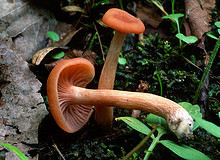Microbial activity is crucial for breaking down compounds, removing pollutants and chemically transforming organic compounds. Some of these pollutants are polycyclic aromatic hydrocarbons (PAHs) found in contaminated soils. The PAH phenanthrene, for example, can be broken down by the bacterium Arthobacterphenanthrenivorans, which was isolated from a creosote-polluted site in Greece, and used by the microbe…
Dietary impacts on hoatzin crop microbial communities
Many DOE JGI metagenomic projects focus on microbial communities in the guts of the cow, termite and even the desert locust, all known to break down plant biomass for energy. In studying these and other gut microbial communities, researchers hope to identify and isolate genes involved in plant biomass degradation, and apply them to biofuel…
2013 federal budget proposal in GenomeWeb Daily News
The Department of Energy’s Office of Science, which funds the Joint Genome Institute and other biology research aimed at developing better renewable biofuels and energy-related technologies, would receive $5 billion, compared to $4.9 billion this fiscal year. Read the full GenomeWeb News story on the Obama administration’s 2013 budget proposal.
A new approach for improve genome assembly
Assembling a genome from fragments of DNA sequence is often compared to assembling a puzzle. One of the problems researchers face with the increasing use of next-generation sequencing technologies is that the pieces of DNA sequence generated by the 454 or Illumina platforms are much smaller and far more numerous than those produced by the…
The role of hydrophobins in plant-fungal mutualism
To get an idea of the importance of mutualistic relationships between plants and fungi, consider that a third of the carbon sequestered in the soil of boreal forests are composed of the wood residues after the fungi break down the cellulose. Maintaining the interface between the fungi and their hosts is the job of small…
Permafrost study referenced in ScienceNews
In Nature in December, a team of researchers at the Department of Energy’s Joint Genome Institute in Walnut Creek, Calif., and colleagues reported one such microbe’s draft genome — put together from DNA acquired from the semifrozen dirt in an Alaskan black spruce forest. The Alaskan microbe carries genes tuned to transform organic matter into methane, a finding that…
A toolkit for T. reesei
The availability of an organism’s genome sequence is useful for improving downstream applications such as large-scale biofuel production, but it is only the first step on this path. In the case of the fungus Trichoderma reesei, whose genome sequence was published by the DOE JGI in 2008, the cellulases in T. reesei have multiple industrial…
1000 Fungal Genomes project in The Daily Barometer
Joey Spatafora, an associate professor at Oregon State University, is leading an international project to sequence the genomes of a thousand fungi, a project aptly named 1000 fungal genomes. “It’s a really, really exciting time in fungal biology because we can sequence fungal genomes more easily than we could ten years ago,” Spatafora said. The Daily Barometer
Cotton project in the Delta Farm Press
An international consortium, led by Professor Andrew Paterson of the University of Georgia, has made publicly available the first ‘gold-standard’ genome sequence for cotton. Cotton was among the first plants studied at the molecular level, and the sequence obtained by Paterson and his team is the culmination of a 20-plus year effort in the analysis…
Cyanobacteria shed light on carboxysome complexity
Found in temperate and tropical oceans, Prochlorococcus cyanobacteria are considered the world’s most abundant photosynthetic organisms, able to convert sunlight to energy at depths of 200 meters. Despite their size, they are estimated to contribute up to half of the marine biological carbon sequestration. Prochlorococcusis a unicellular cyanobacterium that dominates the temperate and tropical oceans. …
